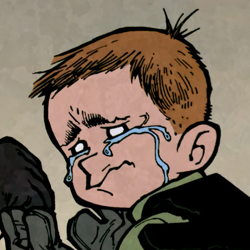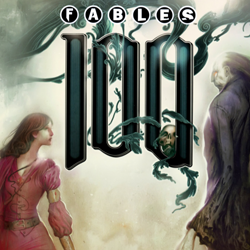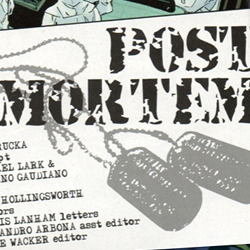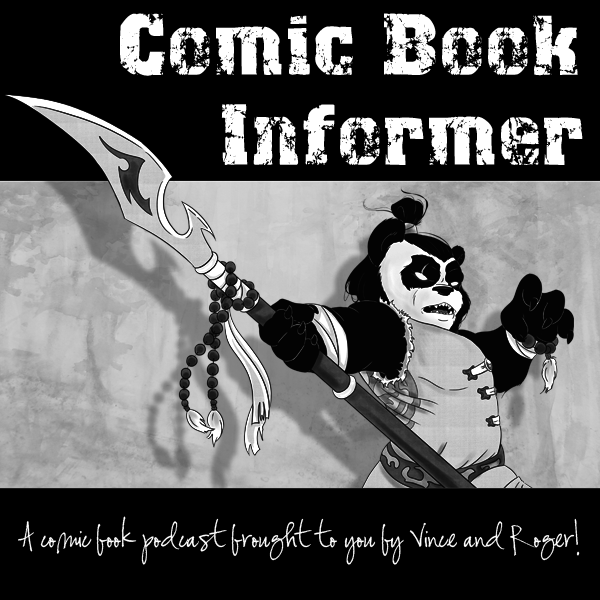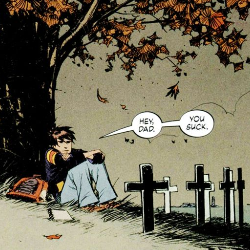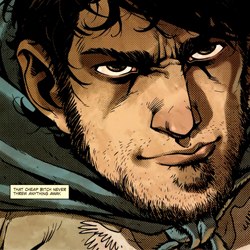The nominations for the Will Eisner awards have been released and posted on the official Comic-Con site. We’ve got the full list here for y’all to peruse as well. This year, we see a shift away from superhero nominations, which is quite refreshing. SAN DIEGO — Comic-Con International (Comic-Con) is proud to announce the nominations for the Will Eisner Comic Industry Awards 2011. The nominees, chosen by a blue-ribbon panel of judges, reflect the wide range of material being published in comics and graphic novel form today, from heartfelt autobiographical works to books aimed at kids and teens to deluxe hardcover archival editions. Unlike in past years, superheroes are very much in the minority in this year’s selections. Will Eisner Comic Industry Awards Nominees, 2011 Best Short Story “Bart on the Fourth of July,” by Peter Kuper, in Bart Simpson #54 (Bongo) “Batman, in Trick for the Scarecrow,” by Billy Tucci, in DCU Halloween Special 2010 (DC) “Cinderella,” by Nick Spencer and Rodin Esquejo, in Fractured Fables (Silverline Books/Image) “Hamburgers for One,” by Frank Stockton, in Popgun vol. 4 (Image) “Little Red Riding Hood,” by Bryan Talbot and Camilla d’Errico, in Fractured Fables (Silverline Books/Image) “Post Mortem,” by Greg Rucka and Michael Lark, in I Am an Avenger #2 (Marvel) Best Single Issue (or One-Shot) The Cape, by Joe Hill, Jason Ciaramella, and Zack Howard (IDW) Fables #100, by Bill Willingham, Mark Buckingham, and others (Vertigo/DC) Hellboy: Double Feature of Evil, by Mike Mignola and Richard Corben (Dark Horse) Locke & Key: Keys to the Kingdom #1: “Sparrow,” by Joe Hill and Gabriel Rodriguez (IDW) Unknown Soldier #21: “A Gun in Africa,” by Joshua Dysart and Rick Veitch (Vertigo/DC) Best Continuing Series Chew, by John Layman and Rob Guillory (Image) Echo, by Terry Moore (Abstract Studio) Locke & Key, by Joe Hill and Gabriel Rodriguez (IDW) Morning Glories, by Nick Spencer and Joe Eisma (Shadowline/Image) Naoki Urasawa’s 20th Century Boys, by Naoki Urasawa (VIZ Media) Scalped, by Jason Aaron and R. M. Guéra (Vertigo/DC) Best Limited Series Baltimore: The Plague Ships, by Mike Mignola, Christopher Golden, and Ben Stenbeck (Dark Horse) Cinderella: From Fabletown with Love, by Chris Roberson and Shawn McManus (Vertigo/DC) Daytripper, by Fábio Moon and Gabriel Bá (Vertigo/DC) Joe the Barbarian, by Grant Morrison and Sean Murphy (Vertigo/DC) Stumptown, by Greg Rucka and Matthew Southworth (Oni) Best New Series American Vampire, by Scott Snyder, Stephen King, and Rafael Albuquerque (Vertigo/DC) iZombie, by Chris Roberson and Michael Allred (Vertigo/DC) Marineman, by Ian Churchill (Image) Morning Glories, by Nick Spencer and Joe Eisma (Shadowline/Image) Superboy, by Jeff Lemire and Pier Gallo (DC) Best Publication for Kids Amelia Earhart: This Broad Ocean, by Sara Stewart Taylor and Ben Towle (Center for Cartoon Studies/Disney/Hyperion) Amelia Rules!: True Things (Adults Don’t Want Kids to Know), by Jimmy Gownley (Atheneum/Simon & Schuster) Binky to the Rescue, by Ashley Spires (Kids Can Press) Scratch9, by Rob M. Worley and Jason T. Kruse (Ape Entertainment) Tiny Titans, by Art Baltazar and Franco (DC) The Unsinkable Walker Bean, by Aaron Renier (First Second) Best Publication for Teens Ghostopolis, by Doug TenNapel (Scholastic Graphix) Hereville: How Mirka Got Her Sword, by Barry Deutsch (Amulet Books) Return of the Dapper Men, by Jim McCann and Janet Lee (Archaia) Smile, by Raina Telgemeier (Scholastic Graphix) Yummy: The Last Days of a Southside Shorty, by G. Neri and Randy DuBurke (Lee & Low) Best Humor Publication Afrodisiac, by Jim Rugg and Brian Maruca (Adhouse) Comic Book Guy: The Comic Book, by Ian Boothby, John Delaney, and Dan Davis (Bongo) Drinking at the Movies, by Julia Wertz (Three Rivers Press/Crown) I Thought You Would Be Funnier, by Shannon Wheeler (BOOM!) Literature: Unsuccessfully Competing Against TV Since 1953, by Dave Kellett (Small Fish Studios) Prime Baby, by Gene Luen Yang (First Second) Best Anthology The Anthology Project, edited by Joy Ang and Nick Thornborrow (Lucidity Press) Korea as Viewed by 12 Creators, edited by Nicolas Finet (Fanfare•Ponent Mon) Liquid City, vol. 2, edited by Sonny Liew and Lim Cheng Tju (Image) Mouse Guard: Legends of the Guard, edited by Paul Morrissey and David Petersen (Archaia) Trickster: Native American Tales, edited by Matt Dembicki (Fulcrum Books) Best Digital Comic Abominable Charles Christopher, by Karl Kerschl, www.abominable.cc The Bean, by Travis Hanson, www.beanleafpress.com Lackadaisy, by Tracy Butler, www.lackadaisycats.com Max Overacts, by Caanan Grall, http://occasionalcomics.com Zahra’s Paradise, by Amir and Khalil, www.zahrasparadise.com Best Reality-Based Work It Was the War of the Trenches, by Jacques Tardi (Fantagraphics) Picture This: The Nearsighted Monkey Book, by Lynda Barry (Drawn & Quarterly) Special Exits: A Graphic Memoir, by Joyce Farmer (Fantagraphics) Treasury of XXth Century Murder: The Terrible Axe Man of New Orleans, by Rick Geary (NBM) Two Generals, by Scott Chantler (McClelland & Stewart) You’ll Never Know Book 2: Collateral Damage, by Carol Tyler (Fantagraphics) Best Graphic Album—New Elmer, by Gerry Alanguilan (SLG) Finding Frank and His Friend: Previously Unpublished Work by Clarence ‘Otis’ Dooley, by Melvin Goodge (Curio & Co.) Market Day, by James Sturm (Drawn & Quarterly) Return of the Dapper Men, by Jim McCann and Janet Lee (Archaia) Wilson, by Daniel Clowes (Drawn & Quarterly) Best Graphic Album—Reprint The Amazing Screw-on Head and Other Curious Objects, by Mike Mignola (Dark Horse) Beasts of Burden: Animal Rites, by Evan Dorkin and Jill Thompson (Dark Horse) Motel Art Improvement Service, by Jason Little (Dark Horse) The Simpsons/Futurama Crossover Crisis, by Ian Boothby, James Lloyd, and Steve Steere Jr. (Abrams Comicarts) Tumor, by Joshua Hale Fialkov and Noel Tuazon (Archaia) Wednesday Comics, edited by Mark Chiarello (DC) Best Adaptation from Another Work Dante’s Divine Comedy, adapted by Seymour Chwast (Bloomsbury) The Little Prince, by Antoine de Saint-Exupéry, adapted by Joann Sfar (Houghton Mifflin Harcourt) The Marvelous Land of Oz, by L. Frank Baum, adapted by Eric Shanower and Skottie Young (Marvel) 7 Billion Needles, vols. 1 and 2, adapted from Hal Clement’s Needle by Nobuaki Tadano (Vertical) Silverfin: A James Bond Adventure, adapted by Charlie Higson and Kev Walker (Disney/Hyperion Books) Best Archival Collection/Project—Strips Archie: The Complete Daily Newspaper Strips, 1946–1948, by Bob Montana, edited by Greg Goldstein (IDW) 40: A Doonesbury Retrospective, by G. B. Trudeau (Andrews McMeel) George Heriman’s Krazy Kat: A Celebration of Sundays, edited by Patrick McDonnell and Peter Maresca (Sunday Press Books) Polly and Her Pals Complete Sunday Comics, vol. 1, by Cliff Sterrett, edited by Dean Mullaney (IDW) Roy Crane’s Captain Easy, vol. 1, edited by Rick Norwood (Fantagraphics) Best Archival Collection/Project—Comic Books Dave Stevens’ The Rocketeer Artist’s Edition, edited by Scott Dunbier (IDW) The Horror! The Horror! Comic Books the Government Didn’t Want You to Read!, edited by Jim Trombetta (Abrams Comicart) The Incal Classic Collection, by Alexandro Jodorowsky and Moebius (Humanoids) Lynd Ward: Six Novels in Woodcuts, edited by Art Spiegelman (The Library of America) Thirteen “Going on Eighteen,” by John Stanley (Drawn & Quarterly) Best U.S. Edition of International Material It Was the War of the Trenches, by Jacques Tardi (Fantagraphics) The Killer: Modus Vivendi, by Matz and Luc Jacamon (Archaia) King of the Flies, Book One: Hallorave, by Mezzo and Pirus (Fantagraphics) The Littlest Pirate King, by David B. and Pierre Mac Orlan (Fantagraphics) Salvatore, by Nicolas De Crécy (NBM) Best U.S. Edition of International Material—Asia Ayako, by Osamu Tezuka (Vertical) Bunny Drop, by Yumi Unita (Yen Press) A Drunken Dream and Other Stories, by Moto Hagio (Fantagraphics) House of Five Leaves, by Natsume Ono (VIZ Media) Naoki Urasawa’s 20th Century Boys, by Naoki Urasawa (VIZ Media) Best Writer Ian Boothby, Comic Book Guy: The Comic Book; Futurama Comics #47–50; Simpsons Comics #162, 168; Simpsons Super Spectacular #11–12 (Bongo) Joe Hill, Locke & Key (IDW) John Layman, Chew (Image) Jim McCann, Return of the Dapper Men (Archaia) Nick Spencer, Morning Glories, Shuddertown, Forgetless, Existence 3.0 (Image) Best Writer/Artist Dan Clowes, Wilson (Drawn & Quarterly) Darwyn Cooke, Richard Stark’s Parker: The Outfit (IDW) Joe Kubert, Dong Xoai, Vietnam 1965 (DC) Terry Moore, Echo (Abstract Studio) James Sturm, Market Day (Drawn & Quarterly) Naoki Urasawa, Naoki Urasawa’s 20th Century Boys (VIZ Media) Best Penciller/Inker or Penciller/Inker Team Richard Corben, Hellboy (Dark Horse) Stephen DeStefano, Lucky in Love Book One: A Poor Man’s Story (Fantagraphics) Rob Guillory, Chew (Image) Gabriel Rodriguez, Locke & Key (IDW) Skottie Young, The Marvelous Land of Oz (Marvel) Best Painter/Multimedia Artist (interior art) Lynda Barry, Picture This: The Nearsighted Monkey Book (Drawn & Quarterly) Brecht Evens, The Wrong Place (Drawn & Quarterly) Juanjo Guarnido, Blacksad (Dark Horse) Janet Lee, Return of the Dapper Men (Archaia) Eric Liberge, On the Odd Hours (NBM) Carol Tyler, You’ll Never Know Book 2: Collateral Damage (Fantagraphics) Best Cover Artist Rodin Esquejo, Morning Glories (Shadowline/Image) Dave Johnson, Abe Sapien: The Abyssal Plain (Dark Horse); Unknown Soldier (Vertigo/DC); Punisher/Max, Deadpool (Marvel) Mike Mignola, Hellboy, Baltimore: The Plague Ships (Dark Horse) David Petersen, Mouse Guard: Legends of the Guard (Archaia) Yuko Shimizu, The Unwritten (Vertigo/DC) Best Coloring Jimmy Gownley, Amelia Rules!: True Things (Adults Don’t Want Kids to Know), Amelia Rules!: The Tweenage Guide to Not Being Unpopular, by Jimmy Gownley (Atheneum/Simon & Schuster) Metaphrog (Sandra Marrs and John Chalmers), Louis: Night Salad (Metaphrog) Dave Stewart, Hellboy, BPRD, Baltimore, Let Me In (Dark Horse); Detective Comics (DC); Neil Young’s Greendale, Daytripper, Joe the Barbarian (Vertigo/DC) Hilary Sycamore, City of Spies, Resistance, Booth, Brain Camp, Solomon’s Thieves (First Second) Chris Ware, Acme Novelty Library 20: Lint (Drawn & Quarterly) Best Lettering Darwyn Cooke, Richard Stark’s Parker: The Outfit (IDW) Dan Clowes, Wilson (Drawn & Quarterly) Jimmy Gownley, Amelia Rules!: True Things (Adults Don’t Want Kids to Know), Amelia Rules!: The Tweenage Guide to Not Being Unpopular, by Jimmy Gownley (Atheneum/Simon & Schuster) Todd Klein, Fables, The Unwritten, Joe the Barbarian, iZombie (Vertigo/DC); Tom Strong and the Robots of Doom (WildStorm/DC); SHIELD (Marvel); Driver for the Dead (Radical) Doug TenNapel, Ghostopolis (Scholastic Graphix) Chris Ware, Acme Novelty Library 20: Lint (Drawn & Quarterly) Best Comics-Related Periodical/Journalism Alter Ego, edited by Roy Thomas (TwoMorrows) The Beat, produced by Heidi MacDonald (www.comicsbeat.com) ComicBookResources, produced by Jonah Weiland (www.comicbookresources.com) ComicsAlliance, produced by Laura Hudson (www.comicsalliance.com) The Comics Reporter, produced by Tom Spurgeon (www.comicsreporter.com) USA Today Comics Section, by Life Section Entertainment Editor Dennis Moore; Comics Section Lead, John Geddes (www.usatoday.com/life/comics/index) Best Comics-Related Book Doonesbury and the Art of G. B. Trudeau, by Brian Walker (Yale University Press) Fire and Water: Bill Everett, the Sub-Mariner, and the Birth of Marvel Comics, by Blake Bell (Fantagraphics) The Oddly Compelling Art of Denis Kitchen, by Denis Kitchen and Charles Brownstein, edited by John Lind and Diana Schutz (Dark Horse Books) Shazam! The Golden Age of the World’s Mightiest Mortal, by Chip Kidd and Geoff Spear (Abrams Comicarts) 75 Years of DC Comics: The Art of Modern Mythmaking, by Paul Levitz (TASCHEN) Best Publication Design Dave Stevens’ The Rocketeer Artist’s Edition, designed by Randall Dahlk (IDW) Polly and Her Pals Complete Sunday Comics, vol. 1, designed by Lorraine Turner and Dean Mullaney (IDW) Return of the Dapper Men, designed by Todd Klein (Archaia) 75 Years of DC Comics: The Art of Modern Mythmaking, designed by Josh Baker (TASCHEN) Two Generals, designed by Jennifer Lum (McClelland & Stewart) Hall of Fame Judges’ Choices: Ernie Bushmiller Jack Jackson Martin Nodell Lynd Ward Source: Comic-Con 2011...
